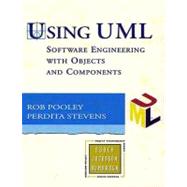
| Conceptual background | |
| Software engineering with components | |
| What is a good system? | |
| Do we have good systems? | |
| What are good systems like? | |
| How are good systems built? | |
| Object concepts | |
| What is an object? .2 How does this relate to the aims of the previous chapter? | |
| Inheritance | |
| Polymorphism and dynamic binding | |
| Introductory case study | |
| The problem | |
| Scope and iterations | |
| Identifying classes | |
| Relations between classes | |
| The system in action | |
| The development process | |
| Defining terms | |
| The development process | |
| System, design, model, diagram | |
| The Unified Modeling Language | |
| Essentials of class models | |
| Identifying objects and classes | |
| Associations | |
| Attributes and operations | |
| Generalisation | |
| The class model during the development | |
| CRC cards | |
| More on class models | |
| More about associations | |
| More about classes | |
| Parameterised classes | |
| Dependency | |
| Components and packages | |
| Visibility, protection | |
| Essentials of use case models | |
| Actors in detail | |
| Use cases in detail | |
| System boundary | |
| Using use cases | |
| Possible problems with use cases | |
| More on use case models | |
| Relationships between use cases | |
| Relationships between actors | |
| Actors and classes | |
| Essentials of interaction diagrams | |
| Collaborations | |
| Interactions on collaboration diagrams | |
| Sequence diagrams | |
| More advanced features | |
| Interaction diagrams for other purposes | |
| More on interaction diagrams | |
| Generic interaction diagrams | |
| Concurrency | |
| Essentials of state and activity diagrams | |
| State diagrams | |
| Activity Diagrams | |
| More on state and activity diagrams | |
| Other kinds of events | |
| Other kinds of actions | |
| Looking inside states | |
| Concurrency within states | |
| Implementation diagrams | |
| Component model | |
| Deployment model | |
| Packages, subsystems, models | |
| Package | |
| Subsystems | |
| Models | |
| Case studies | |
| CS4 administration | |
| The case study | |
| Discussion | |
| Board games | |
| Scope and preliminary analysis | |
| Interaction | |
| Back to the framework | |
| States | |
| Discrete event simulation | |
| Requirements | |
| Outline class model | |
| Use Cases | |
| Standard mechanism for process based simulation | |
| Associations and navigability | |
| Classes in detail | |
| Class Report | |
| Class Statistic | |
| Building a complete simulation model. | |
| The dining philosophers | |
| Towards practice | |
| Reuse: components, patterns | |
| Practicalities of reuse | |
| Design Patterns | |
| Frameworks | |
| Product quality: verification, validation, testing | |
| Quality review | |
| How can high quality be achieved? 19.3 Verification | |
| Validation | |
| Testing | |
| Reviews and inspections | |
| Process quality: management, teams, QA | |
| Management | |
| Teams | |
| Leadership | |
| Quality assurance | |
| Further reading | |
| Table of Contents provided by Publisher. All Rights Reserved. |
The New copy of this book will include any supplemental materials advertised. Please check the title of the book to determine if it should include any access cards, study guides, lab manuals, CDs, etc.
The Used, Rental and eBook copies of this book are not guaranteed to include any supplemental materials. Typically, only the book itself is included. This is true even if the title states it includes any access cards, study guides, lab manuals, CDs, etc.